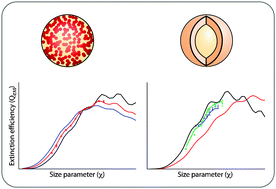Atmospheric aerosols scatter and absorb solar radiation leading to variable effects on Earth’s radiative balance. Aerosols individually comprising mixtures of different components (“internally mixed”) interact differently with light than mixtures of aerosols, each comprising a different single component (“externally mixed”), even if the relative fractions of the different components are equal. In climate models, the optical properties of internally mixed aerosols are generally calculated by using electromagnetic “mixing rules”, which average the refractive indices of the individual components in different proportions, or by using coated-sphere Mie scattering codes, which solve the full light scattering problem assuming that the components are divided into two distinct layers. Because these calculation approaches are in common use, it is important to validate them experimentally. In this article, we present a broad perspective on the optical properties of internally mixed aerosols based on a series of laboratory experiments and theoretical calculations. The optical properties of homogenously mixed aerosols comprised of non-absorbing and weakly absorbing compounds, and of coated aerosols comprised of strongly absorbing, non-absorbing, and weakly absorbing compounds in different combinations are measured using pulsed and continuous wave cavity ring down aerosol spectrometry (CRD-AS). The success of electromagnetic mixing rules and Mie scattering codes in reproducing the measured aerosol extinction values is discussed.

You have access to this article
 Please wait while we load your content...
Something went wrong. Try again?
Please wait while we load your content...
Something went wrong. Try again?


 Please wait while we load your content...
Please wait while we load your content...